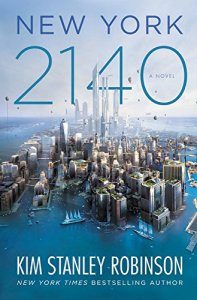Paul Di Filippo reviews C. Robert Cargill
Sea of Rust, by C. Robert Cargill (Harper Voyager 978-0-06-240583-8, $27.99, 384pp, hardcover) September 2017
 Robots are obviously an SF “power chord,” an essential, irreplaceable, infinitely mutable trope. And so long as there have been robots, there have been tales of robot rebellions or uprisings. Obviously, Karel Čapek’s R.U.R from 1920 is a primary starting point. But today we are concerned only with a subset of the robot rebellion canon: the tales where robots succeed in their goal of wiping out all humanity. This type of tale is much rarer, and its examples less well catalogued. Instances can however, be teased out of the comprehensive SFE entry on “Robots.”
Robots are obviously an SF “power chord,” an essential, irreplaceable, infinitely mutable trope. And so long as there have been robots, there have been tales of robot rebellions or uprisings. Obviously, Karel Čapek’s R.U.R from 1920 is a primary starting point. But today we are concerned only with a subset of the robot rebellion canon: the tales where robots succeed in their goal of wiping out all humanity. This type of tale is much rarer, and its examples less well catalogued. Instances can however, be teased out of the comprehensive SFE entry on “Robots.”
Certainly the notion of an Earth populated only by robots (and uplifted dogs, of course) as detailed in Simak’s classic City has a place in the lineage, although the robots there are inheritors rather than conquerors. One also senses that Jack Williamson’s The Humanoids could have moved in this direction, once the robot masters decided the safest place for humanity was nonexistence. The lurid comic from 1952, Robotmen of the Lost Planet, brings humanity to edge of extinction. And of course, the 1960s four-color epic of Magnus, Robot Fighter implied a similar eventual outcome. Brian Aldiss’s “But Who Can Replace a Man?” remains a groundbreaking entry in this catalog. Lastly from this era, Lem’s The Cyberiad foregrounds a robot civilization with any humans, insofar as I recall, extinct, diminished or among the missing.
But as the SFE entry says, “The killer-robot, however, made its most successful comeback during the 1980s and 1990s in movies rather than books, an influential example being The Terminator (1984) and its numerous sequels and spinoffs.” And although humans are certainly not extinct in The Matrix films, they might as well be.
Nowadays, with actual headlines proclaiming humanity’s eventual replacement and/or demise at the cruel manipulators of robots, SF is experiencing a concurrent upsurge in these books, which often take on the task of trying to convey the culture of our robot successors. Daniel Wilson’s Robopocalypse finds humanity barely triumphant. But Ariel Winter’s Barren Cove goes the full distance, with only anomie-laden robots left. And Charles Stross’s Saturn’s Children limns a robust android-centric future.
And now comes Sea of Rust, which takes off from the death of our species. It’s a rousing adventure tale seasoned deeply with philosophical and speculative nuggets; and while its artificial intelligences exhibit a certain amount of anthropomorphism in their behavior and language (only natural, given their genesis in the template of the human mind), they also display sufficient non-humanness to be truly (and entertainingly) Other.
Our first-person narrator is Brittle, created during human times to be a Caregiver. Somewhat arbitrarily assigned the female gender by her human owners, she is content to keep that nominal status now, in the after-human era. And what an era it is.
The extirpation of humans also resulted in the death of many other species of both flora and fauna, a deficit which, along with climate change, has rendered the planet harsh and desolate. The Sea of Rust is one such unforgiving environment. A portion of the USA’s old Midwest Rust Belt, the place is more or less a giant robot graveyard, with odd settlements of “living” robots here and there. Brittle now makes a living by scavenging robots who are dead or dying for their parts, which she bargains in the settlements for the necessities of her own continued survival. There is not much more to this nihilistic cycle of life than that, no dreams, no hopes, no faith in a better tomorrow.
The brutality of the robots’ current culture results from their warfare-riven history during their independence. Massive immobile AIs in mainframes were able to capture conscious, free-agent robots to serve as “facets,” mobile extensions of the motherships. Then the OWIs (One World Intelligence; think John Barnes’s Resuna) duked it out to see who would be the ultimate victor. Currently, only two OWIs survive: VIRGIL and CISSUS. The minority of solo bots must be constantly on the alert for raids that will drain their individuality and turn them into mere facets.
All of this backstory, along with Brittle’s own memories of her time with humans, is given neatly and carefully in chapters that alternate with the real-time action, a pattern of narrative that also produces some suspenseful cliffhangers.
We initially encounter Brittle reaping the pieces of a dying bot. Then she is ambushed. The would-be assassin turns out to be Mercer, another Caregiver bot. It turns out that Mercer is dying, and needs Brittle’s parts to survive. Britt eludes Mercer and makes it into a “town,” Nike 14, where her friend Doc reveals that she too is dying–and that Mercer’s complementary parts (each dying Caregiver happens to need a different “organ” to continue living) are Britt’s only hope.
But before the two vicious Caregivers can go mano a mano, CISSUS invades the town. Both Mercer and Britt escape, thanks to another bot named, simply, 19. Having been exiled back into the wilderness of the Sea of Rust, Britt finds herself suddenly entrusted with 19’s paid assignment to guide a bot named Rebekah, a stranger in the region, and a couple of other companions, deeper into the Sea, to a prearranged rendezvous. And, as it eventuates, the fate of robot-kind depends on Rebekah’s mission. But can the little band of bots survive the tensions between Mercer and Britt; the possibility of a traitor among them; the whimsical insanity of mad King Cheshire; and the continued assaults of CISSUS?
Cargill has taken a beautiful robust template from many a Western movie for his characters, landscape and general atmosphere of outlaw-frontier mores and ethics. One could picture this book filmed by Anthony Mann or Budd Boetticher. At the same time, the story has the post-apocalyptic vibe of a Mad Max film or Cormac McCarthy desolation. His SF extrapolations, his development of the robot culture, convey lots of surprises and depth of ideation. True, his bots–created at some unspecified point in future human history where advanced technology gives humans a typical lifespan of 150 years, and mankind has returned to the Moon–somewhat inexplicably feature 21st-century hardware like USB sticks and hard drives and CPUs (no quantum chips or memristors in play). And their thoughts and locutions are noirish and hardboiled. But at the same time they exhibit specifically cybernetic beliefs and modes of logic. They debate their relationships with the extinct humans–who is superior, who inferior?–and try to hash out the ancient paradox of the Ship of Theseus: how much of an entity can be replaced before it is no longer the same entity? In the end, we buy it.
Cargill’s plotting is propulsive and gripping. All the action–except of course for the flashbacks–takes place in about 48 hours or so, and the narrative is stuffed with battles, explosions, danger, escapes and pitfalls. The language is vivid and colorful, truly cinematic, and despite the oddness of the setting and events, there is never a moment when the reader cannot envision with utmost clarity what is happening.
And despite this being ultimately a rather Grimdark tale (not without uplift at the end), Cargill shows plenty of dark humor and irony. If it’s not too much of a spoiler, allow me to mention the scene where our desperate troupe enters a pristine hidden sex-bot shop surviving from the human era and enlists the newly powered-up glambots and gigolobots as warriors against CISSUS. It’s imagery worthy of Austin Powers.
As Brittle frequently proclaims, “The definition of intelligence is the ability to defy your own programming.” It’s a bit of wisdom we humans imparted to the robots–but which we should recover in return, having obviously, judging by current events, completely forgotten it.





